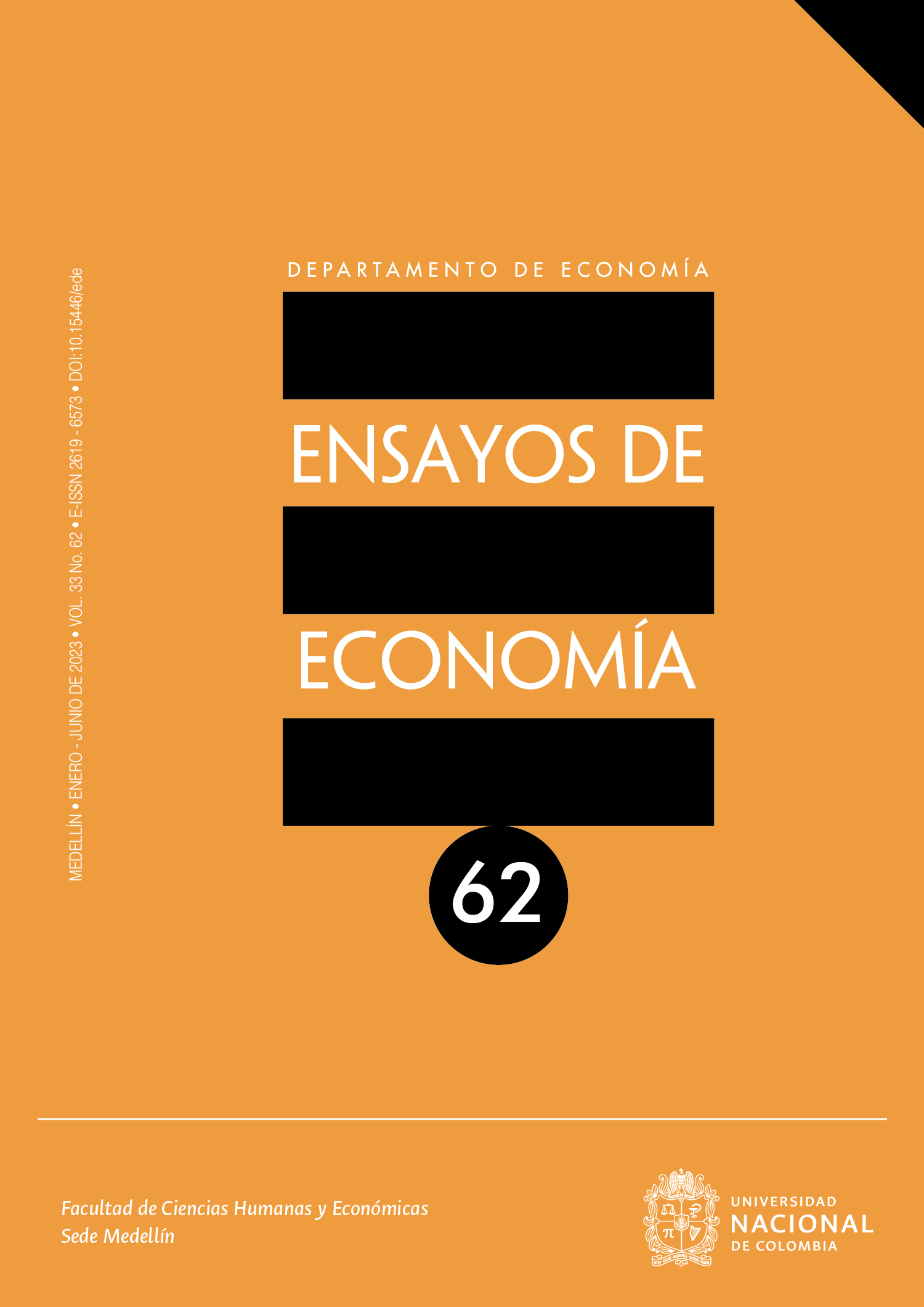El desarrollo (des)encadenado: descifrando el enfoque de Global Value Chains
(Un)Linked Development: Deciphering the Global Value Chains Approach
DOI:
https://doi.org/10.15446/ede.v33n62.101692Palabras clave:
cadenas globales de valor, desarrollo, periferia, Estado, industrialización (es)Global Value Chains, development, periphery, State, industrialization (en)
Descargas
El enfoque de cadenas globales de valor —Global Value Chains (GVC)— ha tenido una relevancia inusitada a lo largo de las últimas dos décadas. Primero en el campo académico y, posteriormente, en la agenda de los organismos internacionales. Su difusión y aceptación generalizada lo han erigido como el nuevo paradigma de desarrollo del siglo XXI. A la luz de ello, este artículo se propone estudiar críticamente sus principales fundamentos teórico-conceptuales a partir de la construcción de una base de datos con sus principales publicaciones. De esta manera, el artículo procura, en primera instancia, dilucidar la evolución de su terminología, sus principales autores, los marcos teóricos asociados, así como la escala y objeto de intervención. Y, en segundo término, intenta reflexionar acerca de los elementos teóricos que aparecen ausentes en el enfoque de GVC para pensar la problemática del desarrollo.
The Global Value Chains (GVC) approach has had an unusual relevance over the last two decades. First in the academic field, and later on the agenda of international organizations. Its diffusion and widespread acceptance have established it as the new development paradigm of the 21st century. In this regard, the article aims to critically study its main theoretical foundations with the construction of a database that contains its main publications. The article seeks, in the first place, to elucidate the evolution of its terminology, its main authors, the associated theoretical frameworks, and the scale and object of intervention. And, in second place, it intends to reflect on the theoretical elements that remain absent in the GVC approach to discuss development strategies.
Referencias
Ali-Yrkkö, J., Rouvinen, P., Seppälä, T., & Ylä-Anttila, P. (2011). Who Captures Value in Global Supply Chains? Case Nokia N95 Smartphone. Journal of Industry, Competition and Trade, 11(3), 263-278. https://doi.org/10.1007/s10842-011-0107-4
Amsden, A. (2001). The Rise of the Rest: Challenges of the West from Late-Industrializing Economies. Oxford University Press. DOI: https://doi.org/10.1093/0195139690.003.0001
Arrighi, G. (1990). The Developmentalist Illusion: A Reconceptualization of the Semiperiphery. En W. Martin (ed.), Semiperipheral States in the World-Economy (pp. 11-42). Greenwood Press.
Arrighi, G. (1999). El largo siglo XX. Akal.
Arrighi, G., Silver, B., & Brewer, B. (2003). Industrial Convergence, Globalization, and the Persistence of North–South Divide. Studies in Comparative International Development, 38(1), 3-31. https://doi.org/10.1007/bf02686319
Bain, C. (2010). Governing the Global Value Chain: GLOBALGAP and the Chilean Fresh Fruit Industry. International journal of sociology of agriculture and food, 17(1), 1-23. https://doi.org/10.48416/ijsaf.v17i1.265
Bair, J. (2009). Global Commodity Chains: Genealogy and Review. En J. Bair (ed.), Frontiers of Commodity Chain Research (pp.1-34). Stanford University Press. DOI: https://doi.org/10.1515/9780804779760-003
Bair, J., & Gereffi, G. (2001). Local Clusters in Global Chains: The Causes and Consequences of Export Dynamism in Torreon’s Blue Jeans Industry. World Development, 29(11), 1885-1903. https://doi.org/10.1016/s0305-750x(01)00075-4
Baldwin, R. (2013). Global Supply Chains: Why They Emerged, Why They Matter, and Where They Are Going. En D. Elms & P. Low (eds.), Global Value Chains in a Changing World (pp. 13-59). WTO Secretariat. DOI: https://doi.org/10.30875/3c1b338a-en
Bamber, P., & Staritz, C. (2016). The Gender Dimensions of Global Value Chains. International Center for Trade and Sustainable Development. https://www.tralac.org/images/docs/10585/the-gender-dimensions-of-global-value-chains-ictsd-september-2016.pdf
Bazan, L., & Navas-Alemán, L. (2004). The Underground Revolution in the Sinos Valley: A Comparison of Upgrading in Global and National Value Chains. En H. Schmitz (ed.), Local enterprises in the global economy. Issues of governance and upgrading (pp. 110-139). Edward Elgar. DOI: https://doi.org/10.4337/9781843769743.00012
Chang, H.J. (2004). Regulation of Foreign Investment in Historical Perspective. European Journal of Development Research, 16(3), 687-715. https://doi.org/10.1080/0957881042000266660
Coe, N., Hess, M., Yeung, H., Dicken, P., & Henderson, J. (2004). ‘Globalizing’ Regional Development: A Global Production Networks Perspective. Transactions of the Institute of British Geographers, 29(4), 468-484. https://doi.org/10.1111/j.0020-2754.2004.00142.x
Dalle, D., Fossati, V., & Lavopa, F. (2013). Política industrial: ¿el eslabón perdido en el debate de las Cadenas Globales de Valor? Revista Argentina de Economía Internacional, (2), 3-16. http://mesi.webiiep.econ.uba.ar/media/uploads/files/impacto_manzanas.pdf
Di Filippo, A. (1998). La visión centro periferia hoy. Revista de la CEPAL, RCEX01, 175-185. https://repositorio.cepal.org/handle/11362/12135
Dolan, C., & Humphrey, J. (2000). Governance and Trade in Fresh Vegetables: The Impact of UK Supermarkets on the African Horticulture Industry. Journal of Development Studies, 37(2), 147–176. https://doi.org/10.1080/713600072
Durand, C., & Milberg, W. (2020). Intellectual Monopoly in Global Value Chains. Review of International Political Economy, 27(2), 404-429. https://doi.org/10.1080/09692290.2019.1660703
Fernández, V. (2017). La trilogía del erizo-zorro. Redes globales, trayectorias nacionales y dinámicas regionales desde la periferia. Anthropos-UNL.
Fernández, V., & Trevignani, M. (2015). Cadenas globales de valor y desarrollo: Perspectivas críticas desde el Sur Global. DADOS, 58(2). https://doi.org/10.1590/00115258201551
Fridell, G., & Walker, C. (2019). Social Upgrading as Market Fantasy: The Limits of Global Value Chain Integration. Human geography, 12(2), 1-17. https://doi.org/10.1177/194277861901200201
Gereffi, G. (1995). Global Production Systems and Third World Development. En B. Stallings (ed.), Global Change, Regional Response (pp. 100-142). Cambridge University Press. DOI: https://doi.org/10.1017/CBO9781139174336.004
Gereffi, G. (2014). Global value chains in a post-Washington Consensus world. Review of International Political Economy, 21(1), 9-37. https://doi.org/10.1080/09692290.2012.756414
Gereffi, G., Korzeniewicz, M., & Korzeniewicz, R. (1994). Introduction: Global Commodity Chains. En G. Gereffi & M. Korzeniewicz (eds.), Commodity chains and global capitalism (pp.1-14). Praeger.
Gereffi, G., Humphrey, J., Kaplinsky, R., & Sturgeon, T. (2001). Globalization, Value Chains and Development. IDS Bulletin, 32(3), 1-8. https://doi.org/10.1111/j.1759-5436.2001.mp32003001.x
Gereffi, G., Humphrey, J., & Sturgeon, T. (2005). The Governance of Global Value Chains. Review of International Political Economy, 12(1), 78-104. https://doi.org/10.1080/09692290500049805
Gibbon, P., & Ponte, S. (2008). Global Value Chains: From Governance to Governmentality? Economy and Society, 37(3), 365-392. https://doi.org/10.1080/03085140802172680
Global Value Chains (s.f.). Global Value Chains Initiative. Consultado el 15 de enero de 2022. https://www.globalvaluechains.org/
Granovetter, M. (1985). Economic Action, and Social Structure: The Problem of Embeddedness. American Journal of Sociology, 91(3), 481-510. https://doi.org/10.1086/228311
Hauge, J. (2020). Industrial Policy in the Era of Global Value Chains: Towards a Developmentalist Framework Drawing on the Industrialization Experiences of South Korea and Taiwan. The World Economy, 43(8), 2070-2092. https://doi.org/10.1111/twec.12922
Henderson, J., Dicken, P., Hess, M., Coe, N., & Yeung, H. (2002). Global Production Networks and the Analysis of Economic Development. Review of International Political Economy, 9(3), 436-464. https://doi.org/10.1080/09692290210150842
Hopkins, T., & Wallerstein, I. (1986). Commodity Chains in the World Economy Prior to 1800. Review, 10(1), 157–170. http://www.jstor.org/stable/40241052
Horner, R., & Alford, M. (2019). The Roles of the State in Global Value Chains: An Update and Emerging Agenda [Global Development Institute Working Paper Series, No. 2019-036]. University of Manchester. https://hummedia.manchester.ac.uk/institutes/gdi/publications/workingpapers/GDI/GDI-working-paper-2019036-Horner-Alford.pdf DOI: https://doi.org/10.4337/9781788113779.00044
Humphrey, J., & Schmitz, H. (2002). How Does Insertion in Global Value Chains Affect Upgrading in Industrial Clusters? Regional Studies, 36(9), 1017-1027. https://doi.org/10.1080/0034340022000022198
Latour, B. (2005). Reassembling the social: an introduction to Actor-Network-Theory. Oxford University Press. DOI: https://doi.org/10.1093/oso/9780199256044.001.0001
Linden, G.; Kraemer, K., & Dedrick, J. (2009). Who Captures Value in a Global Innovation Network? Communications of the ACM, 52(3), 140-144. https://doi.org/10.1145/1467247.1467280
Lund-Thomsen, P., & Nadvi, K. (2010). Clusters, Chains and Compliance: Corporate Social Responsibility and Governance in Football Manufacturing in South Asia. Journal of Business Ethics, 93(2), 201-222. https://doi.org/10.1007/s10551-010-0561-7
Milberg, W., Jiang, X., & Gereffi, G. (2014). Industrial Policy in The Era of Vertically Specialized Industrialization. En J. Salazar-Xirinachs, N. Nübler & R. Kozul-Wright (eds.), Transforming economies: making industrial policy work for growth, jobs and development (pp. 151-178). ILO.
Neilson, J. (2014). Value Chains, Neoliberalism and Development Practice: The Indonesian Experience. Review of International Political Economy, 21(1), 38-69. https://doi.org/10.1080/09692290.2013.809782
Perroux, F. (1948). Esquisse d’une théorie de l’économie dominante. Economie Appliquée, 1(2-3). DOI: https://doi.org/10.3406/ecoap.1948.2433
Piore, M., & Sabel, C. (1984). The Second Industrial Divide. Possibilities for Prosperity. Basic Books.
Ponte, S. (2004). Standards and Sustainability in the Coffee Sector: A Global Value Chain Approach [working paper] International Institute for Sustainable Development. UNCTAD. https://www.iisd.org/system/files/publications/sci_coffee_standards.pdf
Porter, M. (1985). Competitive advantage: Creating and sustaining superior performance. Free Press.
Prebisch, R. (1986). El desarrollo económico de la América Latina y algunos de sus principales problemas. Desarrollo Económico, 26(103), 479-502. https://doi.org/10.2307/3466824
Responsible Global Value Chains. (s.f.). Rethinking Global Value Chains. Consultado el 15 de enero de 2022. https://rgvc.org/
Rossi, A. (2019). Applying the GVC framework to policy: The ILO experience. Journal of International Business Policy, 2(3), 211–216. https://doi.org/10.1057/s42214-019-00031-y
Schmitz, H. (2004). Local Enterprises in the Global Economy. Issues of Governance and Upgrading. Edward Elgar. DOI: https://doi.org/10.4337/9781843769743
Serfati, C., & Sauviat, C. (2019). Global Supply Chains and Intangible Assets in the Automotive and Aeronautical Industries. International Journal of Automotive Technology and Management, 19(3/4), 183. https://doi.org/10.1504/ijatm.2019.10022003
Smith, A., Rainnie, A., Dunford, M., Hardy, J., Hudson, R., & Sadler, D. (2002). Networks of Value, Commodities and Regions: Reworking Divisions of Labour in Macro-Regional Economies. Progress in Human Geography, 26(1), 41-63. https://doi.org/10.1191/0309132502ph355ra
Storper, M., & Scott, A. (1989). The Geographical Foundations and Social Regulation of Flexible Production Complexes. En J. Wolch & M. Dear (eds.), The power of Geography (pp.19-40). Unwin Hyman.
Sunkel, O., & Paz, P. (1970). El subdesarrollo latinoamericano y la teoría del desarrollo. Siglo XXI.
Szirmai, A. (2013). Manufacturing and Economic Development. En A. Szirmai, W. Naudé, y L. Alcorta (Eds.), Pathways to Industrialization in the Twenty-First Century. New Challenges and Emerging Paradigms. Oxford: Oxford University Press. DOI: https://doi.org/10.1093/acprof:oso/9780199667857.001.0001
Trienekens, J., & van Dijk, M. (2012). Upgrading of Value Chains in Developing Countries. En M. van Dijk & J. Trienekens (eds.), Global Value Chains. Linking local Producers from Developing Countries to International Markets (pp. 237-250). Amsterdam University Press. DOI: https://doi.org/10.1017/9789048514991.010
Wade, R. (1990). Governing the Market: Economic Theory and the Role of Government in East Asia’s Industrialization. Princeton University Press. DOI: https://doi.org/10.1515/9780691187181
Werner, M., Bair, J., & Fernández, V. R. (2014). Linking Up to Development? Global Value Chains and The Making of a Post-Washington Consensus. Development and Change, 45(6), 1219-1247. https://doi.org/10.1111/dech.12132
Cómo citar
APA
ACM
ACS
ABNT
Chicago
Harvard
IEEE
MLA
Turabian
Vancouver
Descargar cita
Licencia

Esta obra está bajo una licencia internacional Creative Commons Atribución-NoComercial-SinDerivadas 4.0.
Se autoriza la reproducción sin ánimo de lucro de los materiales, citando la fuente.



























